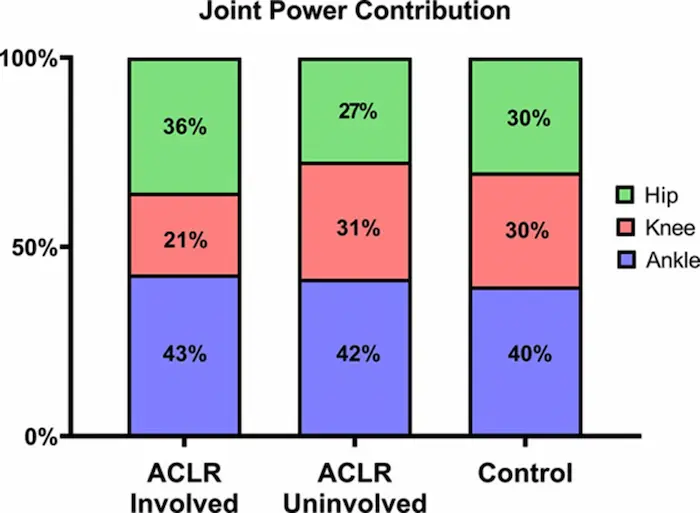Torque is defined as “a measure of force causing rotation around an axis” and more specifically, “the rate of change of angular momentum that would be imparted to an isolated body”. More than half of clinicians use only time from surgery as their metric for deciding when an athlete can return to sport (Burgi et al., 2019). For the small percentage that actually use objective measures for testing, the vast majority use limb symmetry as their primary metric for measuring strength. Limb symmetry is, briefly, comparing the performance of one limb compared to the other (non-involved) limb with the goal of becoming symmetrical over time. For the minority of clinicians that are actually using objective strength testing to guide clinical practice, it should be stated that limb symmetry is likely not enough and may “overestimate knee function” (Wellsandt et al., 2017).
Clinicians should be using not only limb symmetry but also aiming for strength standards based on bodyweight ratios. While the early phases may prioritize symmetry, this is defined as “relative strength” (ie. how strong they are compared to their uninvolved side), this metric should evolve thereafter into “absolute strength” or how strong they should be. In a recent study by Van Wyngaarden et al., they found that a 1.0 N·m/kg improvement in torque to bodyweight improved subjective knee reporting indexes by an average of 17 points! (2021). This is in support of additional research showing athletes who demonstrated ≥3.10 N·m·kg−1 torque to bodyweight ratio had “over eight times higher odds of reporting an IKDC score ≥90%”. (Pietrosimone et al. 2016).
Aiming for a standard torque to body weight goal of 2.5-3.0 N·m/kg (converted to roughly 1.0 lb-ft/lb) for knee extension strength has not only been established to improve subjective knee reporting but we also see athletic performance reflect this measure. For example, knee extension weakness has been demonstrated to show poor single leg vertical jump height. (Fischer et al. 2017) Similarly, Graham et al. (2023) demonstrated notable alterations in jumping mechanics with those athletes who did not meet strength criteria. Their group found the surgical knee was consistently weaker (1.85 ± 0.53 N·m/kg) than both the uninvolved limb (2.95 ± 0.54 N·m/kg) and when compared to controls (2.49-2.55 ± 0.75-.77 N·m/kg for left and right limbs) in athletes at 6 months post-ACL reconstruction. In fact, over 60% of their participants did not meet minimum torque ratios of 2.1N·m/kg a time of testing. Specifically, the surgical knee contributed, on average, 21% less joint power across all jumping tasks compared to the uninvolved knee and compared to controls.

Image source: Graham et al. 2023
Single leg vertical jump testing has been shown to be a superior metric for measuring knee function in ACLr patients compared to horizontal hop testing (Kotsifaki et al., 2021) and its relationship to knee torque is, at least in part, explained above. If our goal is to restore knee function, athletic performance and athlete confidence after ACL reconstruction, knee extension torque to body weight is an essential (and easy) metric that should be included in all evidence-based ACL rehab.
At Nevada Physical Therapy, we begin knee extension isometric training early in the process, often before patients are even off their crutches. Early open-kinetic chain training has shown superior knee extension torque strength at both 3 and 6 months compared to classic closed-kinetic chain programming without increase in joint laxity (Forelli et al. 2023) and we test it often throughout the rehab process. If you are looking for the most up-to-date, evidence-based team in Reno to help you get back to being your best, Nevada Physical Therapy is leading the charge when it comes to ACL rehab. You can call to speak to one of our therapists to learn more here.
References:
Burgi, C. R., Peters, S., Ardern, C. L., Magill, J. R., Gomez, C. D., Sylvain, J., & Reiman, M. P. (2019). Which criteria are used to clear patients to return to sport after primary ACL reconstruction? A scoping review. British journal of sports medicine, 53(18), 1154–1161.
Wellsandt, E., Failla, M. J., & Snyder-Mackler, L. (2017). Limb Symmetry Indexes Can Overestimate Knee Function After Anterior Cruciate Ligament Injury. The Journal of orthopaedic and sports physical therapy, 47(5), 334–338.
Van Wyngaarden, J. J., Jacobs, C., Thompson, K., Eads, M., Johnson, D., Ireland, M. L., & Noehren, B. (2021). Quadriceps Strength and Kinesiophobia Predict Long-Term Function After ACL Reconstruction: A Cross-Sectional Pilot Study. Sports health, 13(3), 251–257.
Kotsifaki, A., Van Rossom, S., Whiteley, R., Korakakis, V., Bahr, R., Sideris, V., & Jonkers, I. (2022). Single leg vertical jump performance identifies knee function deficits at return to sport after ACL reconstruction in male athletes. British journal of sports medicine, 56(9), 490–498.
Graham, M. C., Reeves, K. A., Johnson, D. L., & Noehren, B. (2023). Relationship Between Quadriceps Strength and Knee Joint Power During Jumping After ACLR. Orthopaedic journal of sports medicine, 11(3), 23259671231150938.
Fischer, F., Blank, C., Dünnwald, T., Gföller, P., Herbst, E., Hoser, C., & Fink, C. (2017). Isokinetic Extension Strength Is Associated With Single-Leg Vertical Jump Height. Orthopaedic journal of sports medicine, 5(11), 2325967117736766.
Forelli, F., Barbar, W., Kersante, G., Vandebrouck, A., Duffiet, P., Ratte, L., Hewett, T. E., & Rambaud, A. J. M. (2023). Evaluation of Muscle Strength and Graft Laxity With Early Open Kinetic Chain Exercise After ACL Reconstruction: A Cohort Study. Orthopaedic journal of sports medicine, 11(6), 23259671231177594.

